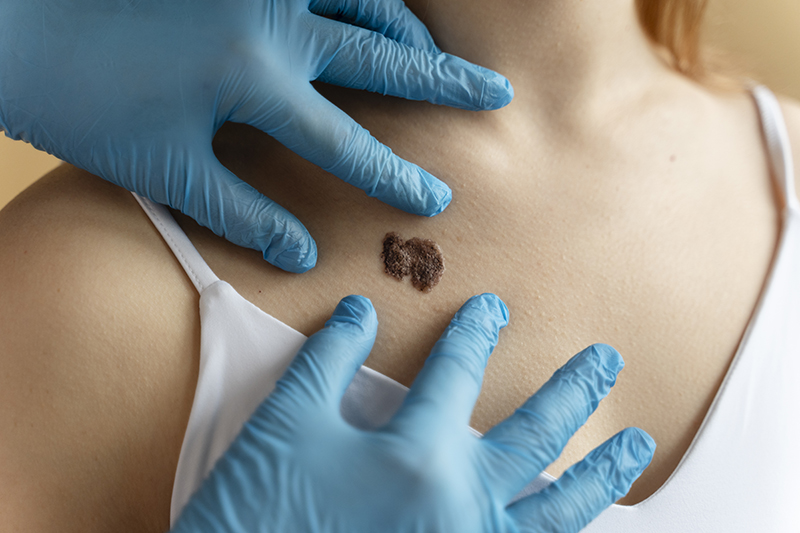Basal cell carcinoma (BCC) is a condition that causes a lump, bump or lesion to form on the outside layer of your skin (epidermis). It most often appears on areas of the skin that are exposed to the sun, such as your head and neck and is caused when one of the skin’s basal cells develops a mutation in its DNA. Treatment for this condition depends on the type, location and size of your cancer. For healthcare providers, accurate documentation and precise ICD-10 coding of basal cell carcinoma is crucial for effective treatment planning and reimbursement. Documentation must provide complete details of the symptoms, diagnostic tests, and treatment plan. Partnering with a reliable medical billing company can ensure accurate code assignment, effective documentation, and clear communication of basal cell carcinoma diagnoses.
Basal cell carcinoma (BCC) can affect anyone but it is slightly more common among men. The condition occurs more often in people older than 50 years. People who have BCC once are at higher risk for developing another non-melanoma skin cancer in the future. The condition appears as a change in the skin, such as a growth or a sore that won’t heal. Usually, these changes in the skin (lesions) are characterized by symptoms such as a shiny, skin-colored bump, a lesion with dark spots, a flat, scaly patch and a white, waxy, scar-like lesion without a clearly defined border.
Struggling with BCC billing and coding?
Get expert assistance to streamline your claims process and maximize reimbursements.
ICD-10 Codes for Basal Cell Carcinoma
Understanding the relevant ICD-10 codes for BCC is crucial for healthcare providers and medical billing specialists. Some of the most commonly used ICD-10 codes for BCC include:
- C44.01 Basal cell carcinoma of skin of lip
- C44.11 Basal cell carcinoma of skin of eyelid, including canthus
- C44.111 Basal cell carcinoma of skin of unspecified eyelid, including canthus
- C44.112 Basal cell carcinoma of skin of right eyelid, including canthus
- C44.1121 Basal cell carcinoma of skin of right upper eyelid, including canthus
- C44.1122 Basal cell carcinoma of skin of right lower eyelid, including canthus
- C44.119 Basal cell carcinoma of skin of left eyelid, including canthus
- C44.1191 Basal cell carcinoma of skin of left upper eyelid, including canthus
- C44.1192 Basal cell carcinoma of skin of left lower eyelid, including canthus
- C44.21 Basal cell carcinoma of skin of ear and external auricular canal
- C44.211 Basal cell carcinoma of skin of unspecified ear and external auricular canal
- C44.212 Basal cell carcinoma of skin of right ear and external auricular canal
- C44.219 Basal cell carcinoma of skin of left ear and external auricular canal
- C44.31 Basal cell carcinoma of skin of other and unspecified parts of face
- C44.310 Basal cell carcinoma of skin of unspecified parts of face
- C44.311 Basal cell carcinoma of skin of nose
- C44.319 Basal cell carcinoma of skin of other parts of face
- C44.41 Basal cell carcinoma of skin of scalp and neck
- C44.51 Basal cell carcinoma of skin of trunk
- C44.510 Basal cell carcinoma of anal skin
- C44.511 Basal cell carcinoma of skin of breast
- C44.519 Basal cell carcinoma of skin of other part of trunk
- C44.61 Basal cell carcinoma of skin of upper limb, including shoulder
- C44.611 Basal cell carcinoma of skin of unspecified upper limb, including shoulder
- C44.612 Basal cell carcinoma of skin of right upper limb, including shoulder
- C44.619 Basal cell carcinoma of skin of left upper limb, including shoulder
- C44.71 Basal cell carcinoma of skin of lower limb, including hip
- C44.711 Basal cell carcinoma of skin of unspecified lower limb, including hip
- C44.712 Basal cell carcinoma of skin of right lower limb, including hip
- C44.719 Basal cell carcinoma of skin of left lower limb, including hip
- C44.81 Basal cell carcinoma of overlapping sites of skin
- C44.91 Basal cell carcinoma of skin, unspecified
Documentation Guidelines for Basal Cell Carcinoma (BCC)
In order to assess any growths or changes in the skin, physicians will perform a general physical examination and a detailed analysis about the patient’s medical history, changes in the skin, or any other signs or symptoms. It is rare for basal cell carcinoma to spread throughout your body. But, if your physician suspects that the cancer has spread elsewhere in your body, they may recommend an MRI or a CT scan to detect cancer in lymph nodes or internal organs. Physicians may also perform a skin biopsy that involve removing a piece of the affected skin area (lesion). Proper documentation of BCC is essential for accurate diagnosis, treatment planning, and reimbursement with the support of medical billing services. Healthcare providers must follow clear and concise guidelines to ensure compliance with regulatory standards and optimize reimbursement processes.
Below discussed are some key documentation guidelines –
- Patient Demographics and Medical History: The first crucial aspect of documentation is recording patient demographics and medical history. This includes the patient’s age, gender, ethnicity, history of sun exposure, use of tanning beds, and any previous diagnoses or treatments for skin conditions. A family history of skin cancer should also be noted, as it can indicate genetic predisposition. Additionally, any underlying medical conditions, medications, or immunosuppressive therapies that could affect treatment outcomes must be documented. These details provide a comprehensive background that supports accurate diagnosis and billing.
- Clinical Presentation and Diagnosis: Physicians should provide a detailed description of the lesion, including its size, location, shape, color, texture, and any ulceration or bleeding. Symptoms reported by the patient, such as itching or tenderness, should be noted. High-quality clinical photographs are essential for tracking lesion progression over time. Diagnostic tests, including dermatoscopy findings and biopsy results, should be recorded with clear pathology reports confirming the presence of basal cell carcinoma. This level of documentation ensures accurate coding and billing while supporting treatment decisions.
- Treatment Plan and Procedures: The treatment plan and procedural details must be documented accurately to justify medical necessity. This includes specifying the recommended treatment approach, such as surgical excision, Mohs micrographic surgery, cryotherapy, radiation therapy, or topical chemotherapy. The documentation should include details of the procedure, such as excision depth, margin status, and any complications encountered during the process. Post-treatment care instructions, including wound management and follow-up visits, should also be documented to ensure comprehensive patient care.
- ICD-10 and CPT Coding Compliance: Accurate use of ICD-10 and CPT codes is crucial for insurance claims. Some relevant ICD-10 codes include:
- C44.01: Basal cell carcinoma of the skin of the lip
- C44.319: Basal cell carcinoma of other parts of the face
- C44.91: Basal cell carcinoma, unspecified site
Common CPT codes for procedural documentation include:
- 11600-11606: Excision of malignant skin lesion
- 17311-17315: Mohs micrographic surgery
Proper documentation of lesion size and excision depth is necessary to ensure that the correct codes are used. Incorrect coding or missing documentation can lead to claim denials.
- Medical Billing and Reimbursement Considerations: Clear and precise documentation supports seamless claims submission and improved reimbursement rates. Insurance companies require comprehensive documentation to verify the necessity of diagnostic tests, treatments, and procedures before processing claims. Healthcare providers should maintain records of pre-authorizations, insurance eligibility checks, and any correspondence with payers regarding coverage policies.
ICD-10 coding for basal cell carcinoma is crucial for accurate billing and claim processing. By opting for medical billing and coding outsourcing, healthcare providers can enhance coding accuracy, minimize administrative workload, and maximize financial efficiency.
Maintain precision and compliance in BCC billing and coding!




